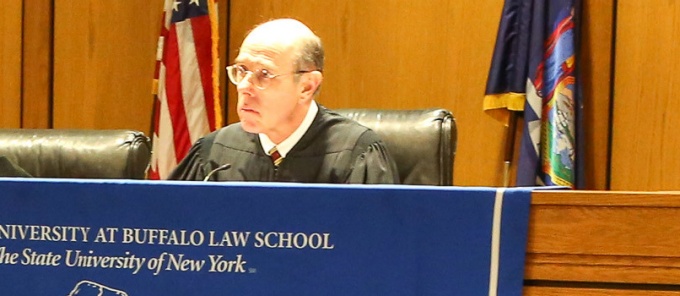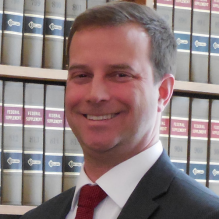
Hon. Eugene Fahey '84 judges the final round of the Charles S. Desmond Moot Court Competition.
NYS Court of Appeals judge and senior law clerk teach spring course
Hon. Eugene Fahey ’84 and Michael Pastrick ’04 share their wisdom in the classroom
A groundbreaking UB law course brings the ultimate insiders’ view of the appeals court process to aspiring attorneys.

Hon. Eugene Fahey ’84
The spring course, Amicus Brief Practicum, is open to second- and third-year law students. It is taught by recently retired New York State Court of Appeals Judge Eugene Fahey ’84 and Michael Pastrick ’04, who served as his senior principal law clerk for many years.
As the name indicates, the practicum introduces students to the fine points of creating a persuasive amicus curiae brief, the friend-of-the-court filing by an interested party not directly involved in the case. “An amicus brief has many important functions,” the course description notes. “It can bolster a party’s brief, provide a more sympathetic or effective advocate, address an important public policy issue, and present evidence to a court outside of the record on appeal.” In addition, the curriculum covers the creation of a bench brief and a proposed opinion, key duties of the law clerk position.

Michael Pastrick ’04
Fahey says he’ll concentrate his teaching on the legal history of the amicus brief, whose roots can be traced back to a 1908 case argued before the U.S. Supreme Court by future Justice Louis Brandeis.
“One of things I want the students to be aware of is the extent to which the underlying philosophy and life experience of the judge affects the outcome and point of view in a particular case,” Fahey says. “Judges are aware of their own failings, and they’re sensitive to that. But that doesn’t mean that they’re immune to argument. So don’t make the mistake of just knowing the law—know the judges, too.”
Just out of law school, Fahey was a law clerk in the New York Court of Claims. But the scope of that court was limited, he says. He learned the nuances of appellate work once appointed to the Appellate Division, Fourth Department bench in 2016, and from 2015 to last year on the Court of Appeals, the state’s highest court.
He says the amicus briefs he has seen vary widely. “The quality ranged from very, very good, helping the judges understand the case and reach a decision, to some that just reiterated points that the parties to the case had already put in their briefs,” Fahey says. “Those briefs tended to be a waste of time.”
Pastrick, who was Judge Fahey’s principal law clerk in the Fourth Department before accompanying the judge to the Court of Appeals, now serves in that same role for State Supreme Court Justice Amy Martoche '99. He has taught an intensive course on the appeals process at the law school previously, and for 10 years served as supervising attorney of law students in externship placements with the court.
The new course, he says, will cover the basics—how to communicate with a judge, how to brief a case—and then offer students the opportunity to draft an amicus brief for a case currently before the appeals courts.
An appeals case, Pastrick says, is like a pyramid: it begins with the wide base of the record and all the materials before the court, then moves to the narrower focus of the law clerk’s bench brief from which the judge may draw to render a first draft of their opinion. In introducing the process to students, he says, “We want them to learn to write like court attorneys, and because of that have a better chance of influencing the court.”
It’s important work, and the downstream impact of appellate decisions means that those cases are likely to attract amicus briefs. “Whatever decision is made will affect the entirety of the jurisdiction,” Pastrick says. “These cases are so far-reaching.”